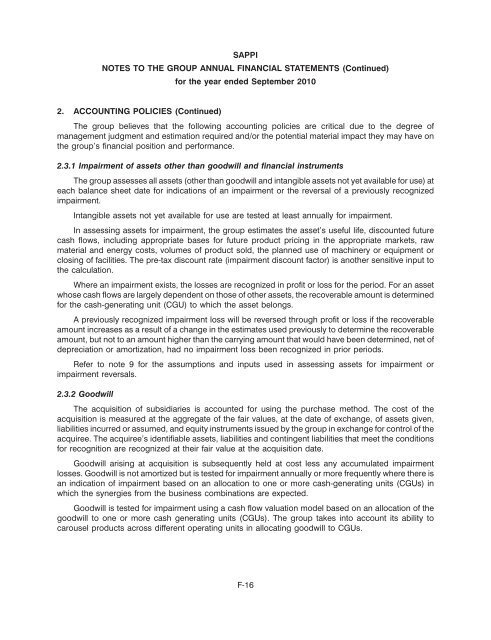You also want an ePaper? Increase the reach of your titles
YUMPU automatically turns print PDFs into web optimized ePapers that Google loves.
<strong>SAPPI</strong><br />
NOTES TO THE GROUP ANNUAL FINANCIAL STATEMENTS (Continued)<br />
for the year ended September 2010<br />
2. ACCOUNTING POLICIES (Continued)<br />
The group believes that the following accounting policies are critical due to the degree of<br />
management judgment and estimation required and/or the potential material impact they may have on<br />
the group’s financial position and performance.<br />
2.3.1 Impairment of assets other than goodwill and financial instruments<br />
The group assesses all assets (other than goodwill and intangible assets not yet available for use) at<br />
each balance sheet date for indications of an impairment or the reversal of a previously recognized<br />
impairment.<br />
Intangible assets not yet available for use are tested at least annually for impairment.<br />
In assessing assets for impairment, the group estimates the asset’s useful life, discounted future<br />
cash flows, including appropriate bases for future product pricing in the appropriate markets, raw<br />
material and energy costs, volumes of product sold, the planned use of machinery or equipment or<br />
closing of facilities. The pre-tax discount rate (impairment discount factor) is another sensitive input to<br />
the calculation.<br />
Where an impairment exists, the losses are recognized in profit or loss for the period. For an asset<br />
whose cash flows are largely dependent on those of other assets, the recoverable amount is determined<br />
for the cash-generating unit (CGU) to which the asset belongs.<br />
A previously recognized impairment loss will be reversed through profit or loss if the recoverable<br />
amount increases as a result of a change in the estimates used previously to determine the recoverable<br />
amount, but not to an amount higher than the carrying amount that would have been determined, net of<br />
depreciation or amortization, had no impairment loss been recognized in prior periods.<br />
Refer to note 9 for the assumptions and inputs used in assessing assets for impairment or<br />
impairment reversals.<br />
2.3.2 Goodwill<br />
The acquisition of subsidiaries is accounted for using the purchase method. The cost of the<br />
acquisition is measured at the aggregate of the fair values, at the date of exchange, of assets given,<br />
liabilities incurred or assumed, and equity instruments issued by the group in exchange for control of the<br />
acquiree. The acquiree’s identifiable assets, liabilities and contingent liabilities that meet the conditions<br />
for recognition are recognized at their fair value at the acquisition date.<br />
Goodwill arising at acquisition is subsequently held at cost less any accumulated impairment<br />
losses. Goodwill is not amortized but is tested for impairment annually or more frequently where there is<br />
an indication of impairment based on an allocation to one or more cash-generating units (CGUs) in<br />
which the synergies from the business combinations are expected.<br />
Goodwill is tested for impairment using a cash flow valuation model based on an allocation of the<br />
goodwill to one or more cash generating units (CGUs). The group takes into account its ability to<br />
carousel products across different operating units in allocating goodwill to CGUs.<br />
F-16
















